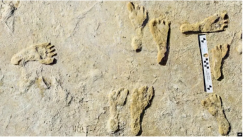When
Around 4, 000 years ago in Babylon, the earliest
To this day, the traditions of the ancient Babylonians and Romans continue on around the world. Google launched a Resolution: Map in 2013,

The tracks found at New Mexico’s White Sands National Park are turning upside down past assumptions on when humans first came into North and South America. They look like they were left behind just moments ago by a barefoot teen visitor to New Mexico’s White Sands National Park, each footprint freshly defined (描出外形) by sand. But this is no tourist track. These footprints are among the oldest evidence of humans in the Americas, marking the latest addition to a growing body of evidence that challenges when and how people first got into this unexplored land.
According to the research team, the footprints were pressed into the mua near an ancient lake at White Sands between 21, 000 and 23, 000 years ago, a time when many scientists think that huge ice sheets walled off human passage into North America.
Exactly when humans populated the Americas has been heatedly debated for nearly a century, and until recently, many scientists insisted that this first occurred no earlier than 13, 000 years ago. A growing number of discoveries suggest people were in North and South America thousands of years before. These include the Monte Verde site in Chile that is as old as 18, 500 years and the Gault site in Texas that is up to 20,000 years old. But each find kicks up a firestorm of controversy among scientists.
While the White Sands discovery doesn’t close the book on these debates, it is stirring excitement. “A discovery like this is very close to finding the Holy Grail (圣杯),” says Ciprian Ardelean, an archacologist at the Chiquihuite Cave in Mexico, where researchers believe they have evidence for human activity in the Americas as early as 30,000 years ago.
If confirmed, the discovery of people in the Americas during the last glacial maximum (末次盛冰期)would require a major change in scientifie thinking about how people arrived in the New Werld.
1. What is the previous conclusion on the first arrivals of Americas?| A.Humans came into Americas about 23, 000 years ago. |
| B.Humans first appeared in Americas to explore the land. |
| C.Humans didn’t arrive in Americas until 13, 000 years ago. |
| D.Humans couldn’t enter Americas because of White Sands. |
| A.To add evidence. | B.To introduce the background. |
| C.To give data. | D.To end the debate. |
| A.Excitement. | B.Argument. | C.Disagreement. | D.Interest. |
| A.Trustworthy. | B.Questionable. | C.Inspiring. | D.Disappointing. |
| A.Humans populated the Americas for nearly one hundred years. |
| B.The tracks were found at New Mexico’s White Sands National Park. |
| C.The footprints are among the oldest evidence of humans in the Americas. |
| D.Surprising footprints push back human arrival in Americas by thousands of years. |
3 . Have you ever wondered why people drive on a different side of the road? It might seem bizarre that U. K. Drivers stay on the left, but they’re not the only ones. Around 35 percent of the world population do the same, including people in Ireland, Japan, and some Caribbean islands.
Originally, almost everybody traveled on the left side of the road. However their way of transport was quite different from today: Think about four legs instead of four wheels. For Medieval swordsmen on horseback, it made sense to keep to the left to have their right arms closer to their enemies. Getting on or off was also easier from the left side of the horse, and safer done by the side of the road than in the center.
So why did people stop traveling on the left? Things changed in the late 1700s when large wagons (货车) pulled by several pairs of horses were used to transport farm products in France and the United States. The wagon driver sat behind the left horse, with his right arm free to use his whip to keep the horses moving. Since he was sitting on the left position, he wanted other wagons to pass on his left, so he kept to the right side of the road.
The British Government refused to give up their left-hand driving ways, and in 1773 introduced the General Highways Act, which encouraged driving on the left. This was later made law thanks to The Highway Act of 1835.
When Henry Ford showed his Model T in 1908, the driver’s seat was on the left, meaning that cars would have to drive on the right hand side of the road to allow front and back passengers to exit the car onto the roadside. However, British drivers remain on the left, and this is highly unlikely to change.
1. What does the underlined word “bizarre” in Paragraph 1 mean?| A.Funny. | B.Strange. |
| C.Wrong. | D.Difficult |
| A.It was safer to keep on the left |
| B.It was easier to carry goods. |
| C.It was easier for them to fight. |
| D.It was necessary to control the horse. |
| A.Their sitting position. |
| B.The road conditions. |
| C.The number of horses. |
| D.The products in the wagons. |
| A.UK Drivers Still Go On The Left |
| B.Why People Like Sitting On The Left Side |
| C.The History Of Transportation Means |
| D.The Reasons For Different Driving Sides |



